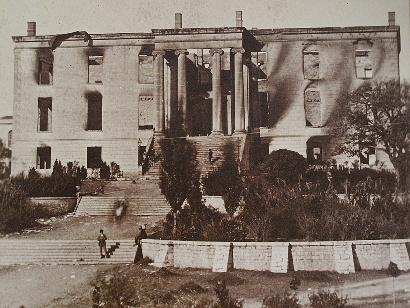|
|
Judging
from the size of the multi-deck headline atop the front page of
the Austin American, the newspaper's readers may have at first thought
something really momentous had happened over night.
But the big type that morning of July 10, 1919 did not herald a
major disaster or the start of a war. This is what it said:
|
Precious
Corner Stone
Of Old Texas Capitol
Recovered by American
Given Governor Hobby |
Long Missing
Famous Relic of Hallowed Texas
Memory Found in Austin, Used as a Stepping Stone, and Restored to
the People of Texas for Preservation in the Archives of the State. |
In one of Texas's
wackiest but least-known newspaper promotional stunts, the Capital
City daily had liberated the 45-year-old stone from a private owner
and returned it to the state. After a first paragraph essentially
repeating what the headline had conveyed, the article waxed on for
another 11 paragraphs about all the history the old cornerstone had
witnessed before finally getting down to the details.
Not that the Austin American hadn't done something good for Texas
in reclaiming the stone, but it was a tad overplayed. The five-year-old
daily had been vigorously competing with the long-established afternoon
paper, the Austin Statesman, and this was just the latest volley.
In time, the American and Statesman would "marry," but that distant
summer less than a year after World
War One, the American was doing everything it could to establish
itself-even taking the law into its own hands.
First
some background. In 1854, nine years after the Republic
of Texas became the state of Texas, workers built a
limestone capitol at the head of Congress Avenue. The structure,
which soon saw the debate over whether Texas should secede from the
Union and later accommodated the lawmakers who wrote the state's constitution,
was functional if decidedly architecturally unimpressive.
State officials were already in the process of reviewing proposed
plans for a new, much larger and aesthetically pleasing capitol when
the ante-bellum statehouse
caught fire on Nov. 8, 1881. The blaze gutted the building, leaving
only a blackened limestone shell. |
 |
|
When the ruins
of the old capitol were razed to make room for the new capitol,
the cornerstone was re-purposed as the cornerstone of the temporary
brick capitol built at the southwest corner of 11th and Congress.
One side of the stone bore the date 1854 and the state seal. Before
construction began on the temporary capital, "1882" was chiseled
on the opposite side of the stone.
The present
red granite capitol was dedicated in 1887 and the building the
temporary capitol had been in was destroyed by fire in 1899. After
that, the old cornerstone ended up in private hands. Eventually,
Otto Stolley came into possession of the stone.
The
American got involved when the newspaper received a letter from
Stolley, a 48-year-old Austin businessman who had recently moved
to Denver in deference to his wife's health. He noted that he owned
the historic cornerstone and had shipped it to Denver. Editor Kendall
B. Cressey then wrote Gov. William P. Hobby and suggested he do
something about getting the stone back into state custody.
Meanwhile, the newspaper got a tip that the cornerstone actually
was still in Austin. It
was being used as a stepping stone in front of a private residence
in Hyde Park. A reporter followed up on that and indeed found the
stone. The owner of the house, a doctor, said Stolley had requested
that he keep it for him.
"Accordingly," the newspaper reported, "the Austin American took
it upon itself to recover this stone. In doing so, the Austin American
believes that it is surely within the law and that the entire transaction
of recovery is animated by the highest spirit of patriotism for
the state of Texas."
In other words, the newspaper seized it without any legal authority
to do so. The work was accomplished by what it called a "Committee
of Recovery." The party included the American's editor, two reporters
and Andrew J. Zilker, a local brick manufacturer who furnished two
workmen and a truck.
Once the heavy stone had been removed, the committee proceeded to
the Capitol
and handed it over to Ralph Soape, the governor's private secretary.
The governor in turn had the stone moved to the Texas State Library,
then located in the Capitol.
In the spring of 1922, back in Austin,
Stolley requested that the state return the stone to him, but the
attorney general told the director of the state library to keep
it unless Stolley was able to provide documentation of his ownership.
Newspapers made no further mention of the matter and what became
of the stone remains a mystery. It is no longer in possession of
the state.
While no one seems to know what became of the relic, a two-paragraph
Associated Press dispatch published on May 6, 1934 reported that
Stolley had died a couple of days earlier from an accidental gunshot
wound at his Round
Rock residence. The article made no mention of Stolley's role
in the Capitol story or the Austin American's brazen "recovery"
of his property.
|
|
|
